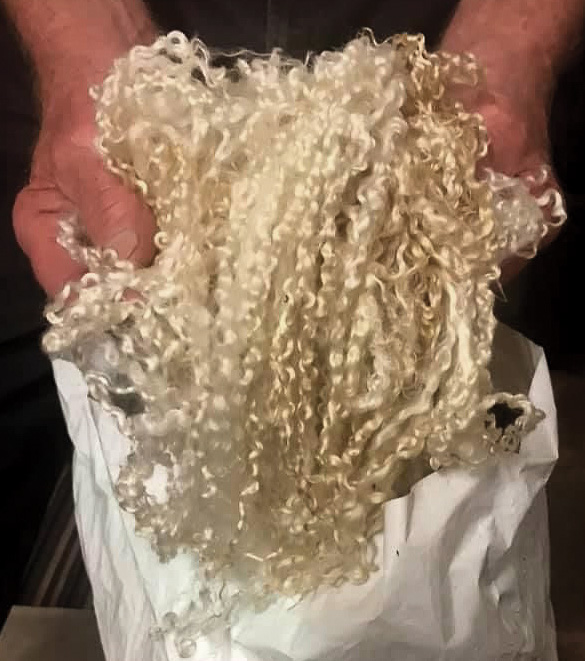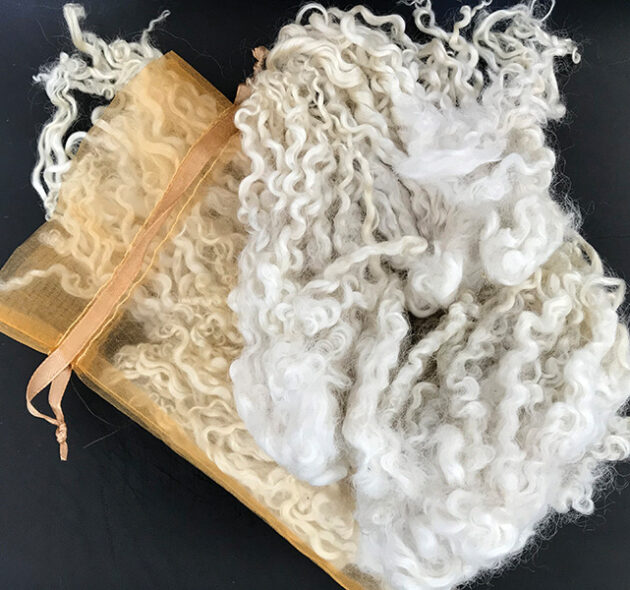Teeswater Sheep and Wool

by Christine Reed
The Teeswater breed is native to the Teesdale area of the County Durham in the United Kingdom. Like many of the British longwool breeds, the Teeswater was subject to breed improvement during the 19th century but it remained a relatively localised breed until the 1920s. The breed was at one time in some danger of becoming extinct. Fortunately a few farmers in the Tees Valley kept the breed alive and distinct for the purpose of breeding rams for crossing with hill ewes. Teeswaters became widely known as the sire of the Masham crossbred (a Teeswater ram over a Dalesbred, Swaledale or Rough Fell ewe) and enjoyed a period of great popularity as a meat and wool breed. They have a characteristic top knot of wool over the eyes and some farmers referred to them as ‘Mug Tups’ because of their facial colour.
The wool of the Teeswater is in demand with hand spinners internationally and is used for worsted suiting, knitting wools, as well as blending with other fibres. Staple length can be 15–30cm and fleeces weigh 4–8kg. The lustrous locks are long with well-developed curl and the fibre measures 30–40 microns. The wool is soft and supple to handle, retaining its curl and lustre after washing. Spinning gives the final product an iridescent sheen.
The Teeswater itself is fairly hardy and can cope with most conditions. Animals are very long lived and ewes can produce lambs at up to 10–12 years old. They are a very prolific breed and can achieve lambing percentages of 250%. Early experience here in New Zealand shows lambs to be medium to large at birth with phenomenal growth rates reaching 48kg after 15 weeks (average 41.2). Ewes weigh around 90kg and rams120kg.
References:
http://www.teeswatersheep.org/sheep.php
https://www.rbst.org.uk/teeswater
My First Play With Teeswater Fleece
by Catherine Jane
As a result of Christine Reed’s article ‘Teeswater Sheep and Wool’ in the December 2020 issue of Creative Fibre magazine, I went online to see what I could find out about this breed. I was immediately taken by the photos of these sheep with their long dreadlocks, which to me looked like something between Suri alpaca and mohair. I could see that felters, as well as spinners of art yarn, would be able to make amazing use of these curly and lustrous locks. In spite of the fact that I don’t usually work with long wools as they don’t suit my style of spinning, I was really keen to try it myself. Having seen from her Facebook page that Christine had previously had some fibre to sell, I asked her if she might have any left. I wanted to see how Teeswater fleece would come out using conventional spinning techniques. She did have some fibre left, and she sent me about 60g of washed fleece

The staples are soft, and as lustrous as English Leicester fleece, but don’t really have a defined crimp, just a curl. They look like ringlets, about thickness of a pencil. I was unsure at first how to prepare them for spinning, but found that a combination of combing and flick carding worked really well.

I held one or two curls in one hand, and working from the tip back towards the cut end, combed them back as far as I could. I then flipped the staples over and opened out the cut end with the flick carder. There was a bit of waste – just under 20% by weight in the end – but the result was wonderful to spin. The fibres were all lined up, and the length and lustrous nature of the fibre made it really easy to spin a truly worsted single.

I decided I’d let the fibre decide how thick it wanted to spin, and it came out surprisingly fine for a strong wool, with the resulting two-fold yarn being a fingering (4 ply equivalent) weight. It is a slightly creamy white colour, very lustrous and drapes beautifully. It’s not as soft as a fine fibre, but not too prickly either.

It wasn’t the easiest of yarns to knit as it had no stretch, but the final result was worth the effort. As there was only about 130m of yarn I was limited in choice as to what I could make, but Ravelry made it really easy to find a suitable pattern, and I made the narrow version of Lace Leaves Scarves by Jackie Erickson-Schweitzer. https://www.ravelry.com/patterns/library/narrow-lace-leaves-scarf
It drapes beautifully and the worsted yarn gave lovely clear stitch definition. I imagine that woven fabric made from this fibre would also have a lovely drape.
